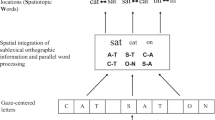Abstract
Even though vowel deletion in Russian is lexically-restricted, the identity of alternating vowels is partially predictable: only mid vowels delete, but even mid vowels cannot delete in some contexts. We report on two nonce word studies asking Russian speakers to rate paradigms in which a vowel was deleted. The ratings strongly correlated with the quality of the vowel: deletion of mid vowels was rated higher than deletion of high and low vowels. We also found that deletion in certain syllabic contexts was rated as ungrammatical: deletion cannot affect words that have a complex coda, and it cannot create clusters with a medial sonorant. Finally, deletion in disyllables was rated higher than deletion in monosyllables, reflecting the trends in the lexicon. These results suggest that even for this lexically-restricted alternation, speakers have formed a phonological generalization.



Similar content being viewed by others
Notes
Yers, or jers, are named after the Old Church Slavonic letters Ь and Ъ, which were used to write the historical ancestors of modern alternating vowels. All Slavic languages have inherited vowel-zero alternations that can be traced to the proto-language, so the term is not specific to Russian (see Jetchev 1997 for Bulgarian; Zec 1988 et seq. for Serbo-Croatian; Kenstowicz and Rubach 1987 for Slovak; Bethin 1992; Rowicka 1999 and many others for Polish).
The following abbreviations are used in glosses: “nom” for “nominative”, “dat” for “dative”, “gen” for “genitive”, “acc” for “accusative”, “inst” for “instrumental”, “sg” for “singular”, “pl” for “plural”, “adj” for “adjective”, “pred” for “predicative”, “dim” for “diminutive”, “masc” for “masculine”, “fem” for “feminine”. All the data are transcribed in IPA and come from one of the authors, unless otherwise indicated. Stress is shown with an acute accent on the vowel that bears it. Yer alternations often cooccur with palatalization alternations; we transcribe but do not analyze them. See Iosad and Morén-Duolljá (2010) and Padgett (2010) for recent discussions of palatalization in Russian.
The first syllable of [kòntr-pr jid-laƷ-énj-ij-ə] has secondary stress because the prefix is exceptional; normally, non-compound phonological words in Russian have only one stress (Gouskova 2010).
This analysis is largely parallel to Gouskova (2012), except that we use constraint cloning rather than Pater-style lexical indexation. The difference between Pater’s (2006) lexical constraint indexation theory and the cloning theory of Becker et al. (2011) is minor. In Pater’s theory, exceptions are indexed to a higher-ranked version of a constraint, and the lower-ranked version of the constraint applies generally, to all items. In the theory of Becker et al., all lexical items are indexed to some constraint: thus, both the higher and the lower ranked clones of a constraint come with a list of morphemes that they apply to.
We use comparative tableaux (Prince 2000). Each row contains a winner ≻ loser comparison, and columns show whether the constraint prefers the winner (W), the loser (L), or neither (empty cell). In a working grammar, at least one W precedes every L in any given candidate comparison row.
Non-mid vowels do alternate with zero elsewhere in Russian. For example, the verbal reflexive suffix [-sja] is realized as [-sj] after vowels; discourse particles [Ʒə] and [bɨ] can also appear as [ʃ] and [p] respectively. Verbal stems have alternations of stressed [i] and other vowels with zero, which have been analyzed as yer deletion (see Gouskova 2012 for arguments against such analyses). In nouns, however, only mid vowels alternate.
We assume that morphemes without mid vowels, such as /mudr/ ‘wise’ in (12c), are not indexed to either clone of *Mid, since they vacuously satisfy it. Nothing crucially depends on this, though—as Gouskova (2012) shows, the analysis works even if learners assume that these morphemes are indexed to *Mid reg .
To implement this analysis explicitly, we would have to assume the Harmonic Serialism view of positional faithfulness constraints (Jesney 2011): since correct syllabification in the input is not guaranteed, faithfulness constraints cannot refer to the initial syllable of a root in the input; the constraints instead refer to the fully faithful candidate that is the first stage of a phonological derivation.
Words such as [sot-ɨ] ‘honeycomb’ historically had yers (Vasmer 1958; Gouskova 2012) but have regularized over time. Monosyllabic words such as [ljot]∼[ljd-a] ‘ice (nom/gen sg)’ seem to be headed in the direction of regularization: they variably keep their vowels in compounds and with derivational suffixes, for example (Gouskova 2010:438–439). Another track for regularization in Russian has been to lose the yer vowel altogether: thus, [mgl-á] ‘mist’, which historically had a yer between the first two consonants, has a paradigm gap in the genitive plural instead of the expected *[mgol] or *[mogl] (cf. the Polish cognate [mgw-a]∼[mgjew]). For more on paradigm gaps in Russian, see Halle (1973) et seq.
A reviewer suggests that the segment-by-segment analyses can be modified to capture the quality generalization: for example, in the moraless analysis, a faithfulness constraint MSeg-μ-[mid] could be ranked above the constraint against moraless vowels and thus prevent mora insertion on mid vowels alone. While it is possible to modify the segment-by-segment analyses in this way, doing so dissolves the very argument for segment-by-segment marking: after all, if the position and quality of alternating vowels follow from the phonological analysis, why do they need to be marked as special in the UR?
Abstract segment-by-segment marking in the UR also does not entirely resolve the problem of lexically-restricted phonology: in Russian, vowel-zero alternation patterns differ in lexical categories, with verbs subject to some constraints and nouns to others (we only examine nouns in this paper). Additional mechanisms are needed to capture such differences.
This is one of many arguments against suppletive allomorphy accounts of phonologically restricted alternations (see Wolf 2013 for more). The original “limited storage” argument against allomorphy and for unique/abstract underlying representations (Chomsky and Halle 1968; Bromberger and Halle 1989) has been challenged by psycholinguistic research (see Vaux 2003 for a detailed literature overview).
The sites were http://odnoklassniki.ru and http://livejournal.com.
One of the co-authors. Moscow Russian is considered to be the broadcast standard dialect.
Prior work suggests that moving stress in Russian from its fixed location in lexically stressed words can result in significantly degraded grammaticality judgments (Gouskova 2010).
The rating data from Experiments 1 and 2 are available at http://becker.phonologist.org/projects/russian/.
A beanplot is a vertical density plot with a horizontal line to mark the mean. The thickest part of the bean corresponds to the greatest number of ratings at that level; thus, the most common rating given to polysyllables with final stress in which the vowel [e] alternates with zero is “7”, with “6” somewhat less common, and the rest of the ratings still less common. These graphs do not include error bars because they show the overall rating distribution for each category and are more informative than barplots or boxplots for rating data.
The individual items’ ratings are: [kjest] 2.58, [stjek] 2.51, [kjetr] 1.37, [spol] 3.57, [motʃ] 2.48, [msjet] 3.22, [sotr] 2.55, [spjer] 3.57, [vosp] 2.17, [vsop] 3.07. Even within those CVCC and CCVC wugs whose clusters are almost completely matched, the CVCC wugs are comparatively worse: for [fsp], [fsop] 3.07≻[vosp] 2.17, for [spr/str], [spjer] 3.57≻[sotr] 2.55). Our statistical model includes a by-item random slope, so the individual variance is taken into account.
References
Albright, Adam, and Bruce Hayes. 2002. Modeling English past tense intuitions with minimal generalization. In Proceedings of the sixth meeting of the ACL special interest group in computational phonology, ed. Michael Maxwell, 58–69. Philadelphia: ACL.
Albright, Adam, and Bruce Hayes. 2003. Rules vs. analogy in English past tenses: A computational/experimental study. Cognition 90 (2): 119–161.
Albright, Adam, and Bruce Hayes. 2006. Modeling productivity with the gradual learning algorithm: The problem of accidentally exceptionless generalizations. In Gradience in grammar: Generative perspectives, eds. Gisbert Fanselow, Caroline Fery, Matthias Schlesewsky, and Ralf Vogel, 185–204. Oxford: Oxford University Press.
Albright, Adam, Argelia Andrade, and Bruce Hayes. 2001. Segmental environments of Spanish diphthongization. In UCLA Working Papers in Linguistics 7 (papers in phonology 5), eds. Adam Albright and Taehong Cho, 117–151. Los Angeles: UCLA.
Bates, Douglas, and Martin Maechler. 2009. lme4: Linear mixed-effects models using S4 classes. R package version 0.999375-32. http://CRAN.R-project.org/package=lme4.
Becker, Michael. 2009. Phonological trends in the lexicon: The role of constraints. PhD dissertation, University of Massachusetts, Amherst, MA.
Becker, Michael, Nihan Ketrez, and Andrew Nevins. 2011. The surfeit of the stimulus: Analytic biases filter lexical statistics in Turkish devoicing neutralization. Language 87 (1): 84–125.
Becker, Michael, Andrew Nevins, and Jonathan Levine. 2012. Asymmetries in generalizing alternations to and from initial syllables. Language 88 (2): 231–268.
Beckman, Jill. 1997. Positional faithfulness, positional neutralization, and Shona vowel harmony. Phonology 14 (1): 1–46.
Beckman, Jill. 1998. Positional faithfulness. New York: Routledge.
Berko, Jean. 1958. The child’s learning of English morphology. Word 14: 150–177.
Bethin, Christina. 1992. Polish syllables: The role of prosody in phonology and morphology. Columbus: Slavica Publishers.
Bobaljik, Jonathan. 2000. The ins and outs of contextual allomorphy. In University of Maryland working papers in linguistics, eds. K. K. Grohmann and Caro Struijke, Vol. 10, 35–71. College Park: University of Maryland.
Bromberger, Sylvain, and Morris Halle. 1989. Why phonology is different. Linguistic Inquiry 20: 51–70.
Bybee, Joan. 1995. Regular morphology and the lexicon. Language and Cognitive Processes 10 (5): 425–455.
Carstairs, Andrew. 1988. Some implications of phonologically conditioned suppletion. In Yearbook of morphology 1988, eds. Geert Booij and Jaap van Marle, 67–94. Dordrecht: Kluwer.
Chomsky, Noam, and Morris Halle. 1968. The sound pattern of English. New York: Harper & Row.
Crosswhite, Katherine. 1999. Vowel reduction in optimality theory. PhD dissertation, UCLA, Los Angeles, CA.
Crothers, John. 1978. Typology and universals of vowel systems. In Universals of human language, ed. Joseph Greenberg. Vol. 2 of Phonology. Stanford: Stanford University Press.
Ernestus, Mirjam, and Harald Baayen. 2003. Predicting the unpredictable: Interpreting neutralized segments in Dutch. Language 79 (1): 5–38.
Flemming, Edward S. 1995. Auditory representations in phonology. PhD dissertation, UCLA, Los Angeles, CA.
Gelman, Andrew, and Jennifer Hill. 2007. Data analysis using regression and multilevel/hierarchical models. New York: Cambridge University Press.
Gelman, Andrew, Yu-Sung Su, Masanao Yajima, Jennifer Hill, Maria Grazia Pittau, Jouni Kerman, and Tian Zheng. 2011. arm: Data analysis using regression and multilevel/hierarchical models. http://CRAN.R-project.org/package=arm.
Gouskova, Maria. 2010. The phonology of boundaries and secondary stress in Russian compounds. The Linguistic Review 17 (4): 387–448.
Gouskova, Maria. 2012. Unexceptional segments. Natural Language & Linguistic Theory 30 (1): 79–133.
Green, Anthony Dubach. 2007. Phonology limited. Vol. 27 of Linguistics in Potsdam. Potsdam: Universitätsverlag Potsdam.
Hall, Daniel Currie. 2011. Phonological contrast and its phonetic enhancement: Dispersedness without dispersion. Phonology 28 (1): 1–54.
Halle, Morris. 1973. Prolegomena to a theory of word formation. Linguistic Inquiry 4: 3–16.
Halle, Morris, and Ora Matushansky. 2006. The morphophonology of Russian adjectival inflection. Linguistic Inquiry 37 (3): 351–404.
Halle, Morris, and Jean-Roger Vergnaud. 1987. An essay on stress. Cambridge: MIT Press.
Harris, James W. 1985. Spanish diphthongization and stress: A paradox resolved. Phonology 2 (1): 31–45.
Hay, Jennifer B., Janet Pierrehumbert, and Mary Beckman. 2003. Speech perception, well-formedness and the statistics of the lexicon. In Phonetic interpretation: Papers in laboratory phonology VI, eds. John Local, Richard Ogden, and Rosalind Temple, 58–74. New York: Cambridge University Press.
Hayes, Bruce. 2004. Phonological acquisition in Optimality Theory: The early stages. In Constraints in phonological acquisition, eds. René Kager, Joe Pater, and Wim Zonneveld. Cambridge: Cambridge University Press.
Hayes, Bruce, and Zsuzsa Cziráky Londe. 2006. Stochastic phonological knowledge: The case of Hungarian vowel harmony. Phonology 23 (1): 59–104.
Hayes, Bruce, Kie Zuraw, Péter Siptár, and Zsuzsa Cziráky Londe. 2009. Natural and unnatural constraints in Hungarian vowel harmony. Language 85 (4): 822–863.
Idsardi, William. 1992. The computation of prosody. PhD dissertation, MIT, Cambridge, MA.
Inkelas, Sharon, and C. Orhan Orgun. 1995. Level ordering and economy in the lexical phonology of Turkish. Language 71 (4): 763–793.
Inkelas, Sharon, Orhan Orgun, and Cheryl Zoll. 1997. The implications of lexical exceptions for the nature of grammar. In Derivations and constraints in phonology, ed. Iggy Roca, 393–418. Oxford: Oxford University Press.
Iosad, Pavel, and Bruce Morén-Duolljá. 2010. Russian palatalization: The true(r) story. Talk presented at the Old world conference in phonology 7, University of Nice, Nice, France. Available at http://www.anghyflawn.net/static/pdf/ocp7.slides.pdf.pdf.
Ito, Junko, and Armin Mester. 1995. The core-periphery structure of the lexicon and constraints on reranking. In Papers in Optimality Theory ii (University of Massachusetts occasional papers in linguistics), eds. Jill Beckman, Laura Walsh Dickey, and Suzanne Urbanczyk, 181–210. Amherst: GLSA Publications.
Jarosz, Gaja. 2008. Partial ranking and alternating vowels in Polish. In Proceedings of CLS 41, eds. Rodney Edwards, Patrick Midtlyng, Colin Sprague, and Kjersti Stensrud, Vol. 1, 193–206. Chicago: Chicago Linguistic Society.
Jesney, Karen. 2011. Positional faithfulness, non-locality, and the harmonic serialism solution. In Proceedings of the 39th meeting of the North East Linguistic Society, eds. Suzi Lima, Kevin Mullin, and Brian Smith, 403–416. Amherst: GLSA Publications. Available on the Rutgers Optimality Archive as ROA-1018.
Jetchev, Georgi Ivanov. 1997. Ghost vowels and syllabification: Evidence from Bulgarian and French. PhD dissertation, Scuola Normale Superiore di Pisa.
Jusczyk, Peter, Paul Luce, and Jan Charles-Luce. 1994. Infants’ sensitivity to phonotactic patterns in the native language. Journal of Memory and Language 33 (5): 630–645.
Kenstowicz, Michael, and Jerzy Rubach. 1987. The phonology of syllabic nuclei in Slovak. Language 63 (3): 463–497.
Kiparsky, Valentin. 1979. Russian historical grammar, Vol. 1. Ann Arbor: Ardis.
Lieber, Rochelle. 1980. On the organization of the lexicon. PhD dissertation, MIT, Cambridge, MA.
Lightner, Theodore. 1965. Segmental phonology of Modern Standard Russian. PhD dissertation, MIT, Cambridge, MA.
Lightner, Theodore. 1972. Problems in the theory of phonology. Edmonton: Linguistic Research, Inc.
Luce, Paul A., and David B. Pisoni. 1998. Recognizing spoken words: The neighborhood activation model. Ear and Hearing 19: 1–36.
Marlett, Stephen, and Joseph P. Stemberger. 1983. Empty consonants in Seri. Linguistic Inquiry 5: 617–639.
Martínez, Michal T. 2008. Exceptions encoded at the segmental level. In Proceedings of WCCFL 26, eds. Charles B. Chang and Hannah J. Haynie, 463–470. Somerville: Cascadilla Press.
Matushansky, Ora. 2002. On formal identity of Russian prefixes and prepositions. In MIT working papers in linguistics 42, 217–253. Cambridge: MIT.
Melvold, Janis. 1989. Structure and stress in the phonology of Russian. PhD dissertation, MIT, Cambridge, MA.
Padgett, Jaye. 2010. Russian consonant-vowel interactions and derivational opacity. In Proceedings of FASL 18, eds. Wayles Browne, Adam Cooper, Alison Fisher, Esra Kesici, Nikola Predolac, and Draga Zec, 352–381. Ann Arbor: Michigan Slavic Publications.
Padgett, Jaye, and Marija Tabain. 2005. Adaptive dispersion theory and phonological vowel reduction in Russian. Phonetica 62 (1): 14–54.
Paster, Mary. 2006. Phonological conditions on affixation. PhD dissertation, UC Berkeley, Berkeley, CA.
Pater, Joe. 2006. The locus of exceptionality: Morpheme-specific phonology as constraint indexation. In Papers in Optimality Theory III, eds. Leah Bateman, Michael O’Keefe, Ehren Reilly, and Adam Werle, 259–296. Amherst: GLSA.
Pater, Joe. 2008. Morpheme-specific phonology: Constraint indexation and inconsistency resolution. In Phonological argumentation: Essays on evidence and motivation, ed. Steve Parker, 123–154. London: Equinox.
Pesetsky, David. 1979. Russian morphology and lexical theory. Ms., MIT. Available at http://web.mit.edu/linguistics/people/faculty/pesetsky/russmorph.pdf.
Pierrehumbert, Janet. 2006. The statistical basis of an unnatural alternation. In Laboratory phonology VIII, eds. Louis Goldstein, Doug Whalen, and Catherine Best. Berlin: Mouton de Gruyter.
Pinker, Steven, and Alan Prince. 1988. On language and connectionism: Analysis of a parallel distributed processing model of language acquisition. Cognition 28: 73–193.
Prince, Alan. 2000. Comparative tableaux. Ms., Rutgers University. Available as ROA-376 on the Rutgers Optimality Archive, http://roa.rutgers.edu.
Prince, Alan, and Paul Smolensky. 1993/2004. Optimality theory: Constraint interaction in generative grammar. Malden, Oxford: Blackwell. Available as ROA-537 on the Rutgers Optimality Archive, http://roa.rutgers.edu.
Prince, Alan, and Bruce Tesar. 2004. Learning phonotactic distributions. In Constraints in phonological acquisition, eds. René Kager, Joe Pater, and Wim Zonneveld, 245–291. Cambridge: Cambridge University Press.
R Development Core Team. 2011. R: A language and environment for statistical computing. Vienna, Austria. http://www.R-project.org.
Revithiadou, Anthi. 1999. Headmost accent wins: Head dominance and ideal prosodic form in lexical accent systems. The Hague: Holland Academic Graphics.
Rowicka, Grazyna. 1999. Prosodic optimality and prefixation in Polish. In The prosody-morphology interface, eds. René Kager, Harry van der Hulst, and Wim Zonneveld, 367–389. Cambridge: Cambridge University Press.
Rubach, Jerzy. 1986. Abstract vowels in three-dimensional phonology: The yers. The Linguistic Review 5 (3): 247–280.
Rubach, Jerzy. 2000. Backness switch in Russian. Phonology 17 (1): 39–64.
Rubach, Jerzy, and Geert Booij. 2001. Allomorphy in optimality theory: Polish iotation. Language 77 (1): 26–60.
Selkirk, Elisabeth. 1984. On the major class features and syllable theory. In Language sound structures, eds. Mark Aronoff and R. T. Oehrle, 107–136. Cambridge: MIT Press.
Sharoff, Serge. 2005. Methods and tools for development of the Russian reference corpus. In Corpus linguistics around the world, eds. Andrew Wilson, Dawn Archer, and Paul Rayson. Language and computers, 167–180. Amsterdam and New York: Rodopi. http://www.comp.leeds.ac.uk/ssharoff/frqlist/frqlist-en.html.
Szpyra, Jolanta. 1992. Ghost segments in nonlinear phonology: Polish yers. Language 68 (2): 277–312.
Usachev, Andrei. 2004. Fully accented paradigms from Zaliznjak’s (1977) grammatical dictionary. http://dict.buktopuha.net/all_forms.rar.
Vasmer, Max. 1958. Russisches etymologisches Wörterbuch [Russian etymological dictionary]. Heidelberg: C. Winter.
Vaux, Bert. 2003. Syllabification in Armenian, universal grammar, and the lexicon. Linguistic Inquiry 34 (1): 91–125.
Vlasto, A. P. 1986. A linguistic history of Russia at the end of the eighteenth century. Oxford: Clarendon Press.
Wolf, Matthew. 2011. Candidate chains, unfaithful spellout, and outwards-looking phonologically-conditioned allomorphy. Ms. Yale University. http://ling.auf.net/lingbuzz/001318.
Wolf, Matthew. 2013. Lexical insertion occurs in the phonological component. In Understanding allomorphy: Perspectives from optimality theory, eds. M. Eulalia Bonet, Maria-Rosa Lloret, and Joan Mascaró. London: Equinox. Available as ROA-912 on the Rutgers Optimality Archive, http://roa.rutgers.edu.
Yearley, Jennifer. 1995. Jer vowels in Russian. In Papers in Optimality Theory II (University of Massachusetts occasional papers in linguistics), eds. Jill Beckman, Laura Walsh Dickey, and Suzanne Urbanczyk, 533–571. Amherst: GLSA Publications.
Zaliznjak, Andrej Anatoljevich. 1977. Grammatičeskij slovar’ russkogo jazyka [A grammatical dictionary of the Russian language]. Moscow: Russkij Jazyk.
Zec, Draga. 1988. Sonority constraints on prosodic structures. PhD dissertation, Stanford University, Stanford, CA.
Zuraw, Kie. 2000. Patterned exceptions in phonology. PhD dissertation, UCLA, Los Angeles, CA.
Acknowledgements
For helpful comments and suggestions, we would like to thank Adam Albright, Ryan Bennett, Junko Ito, Heather Mahan, Armin Mester, Jaye Padgett, Donca Steriade, Colin Wilson, and audiences at New York University, UMass Amherst, the University of California, Santa Cruz, NELS 42, and LSA 86. We would also like to thank Anna Aristova, Yevgenia Gouskova, Vera Gribanova, Stephanie Harves, Pavel Iosad, Sofya Kasyanenko, Inna Livitz, Maria Minchenko, Barbara Partee, Amanda Rysling, as well as the many native Russian speakers for volunteering their time for our study. Special thanks to Junko Ito and the anonymous reviewers for helpful feedback, which has greatly improved the article. Please address correspondence to maria.gouskova@nyu.edu and michael.becker@phonologist.org.
Author information
Authors and Affiliations
Corresponding author
Appendix
Appendix
1.1 Test words used in Experiment 1
-
(25)
Monosyllables (25 pairs)
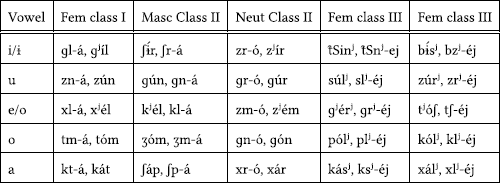
-
(26)
Disyllables (8 pairs, initial stress, all masculines)
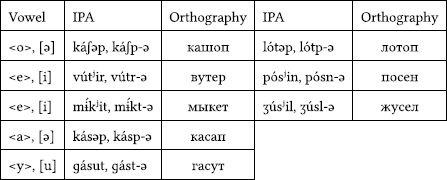
-
(27)
10 disyllables (10 pairs, final stress)
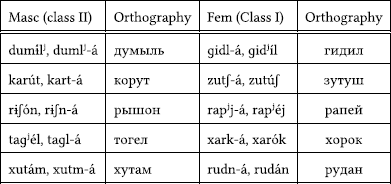
1.2 Test words used in Experiment 2
-
(28)
Stress alternations in disyllables (6 pairs of each type)
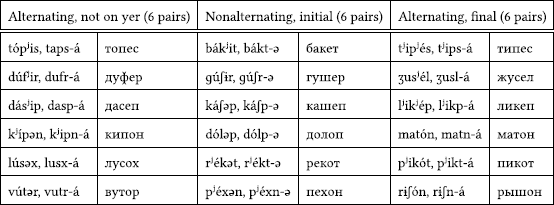
-
(29)
Medial CCC clusters (all with alternating final stress)

-
(30)
Initial CC and CCC clusters
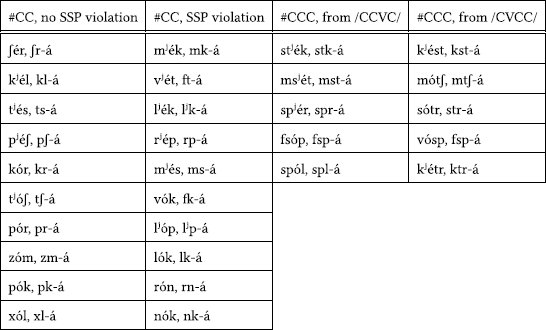
-
(31)
Control stimuli with deletion of [u] (6 pairs)

Rights and permissions
About this article
Cite this article
Gouskova, M., Becker, M. Nonce words show that Russian yer alternations are governed by the grammar. Nat Lang Linguist Theory 31, 735–765 (2013). https://doi.org/10.1007/s11049-013-9197-5
Received:
Accepted:
Published:
Issue Date:
DOI: https://doi.org/10.1007/s11049-013-9197-5




